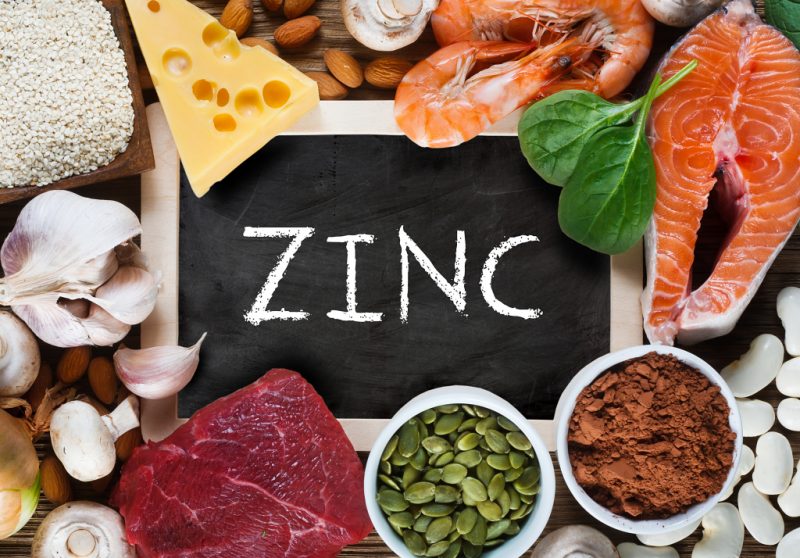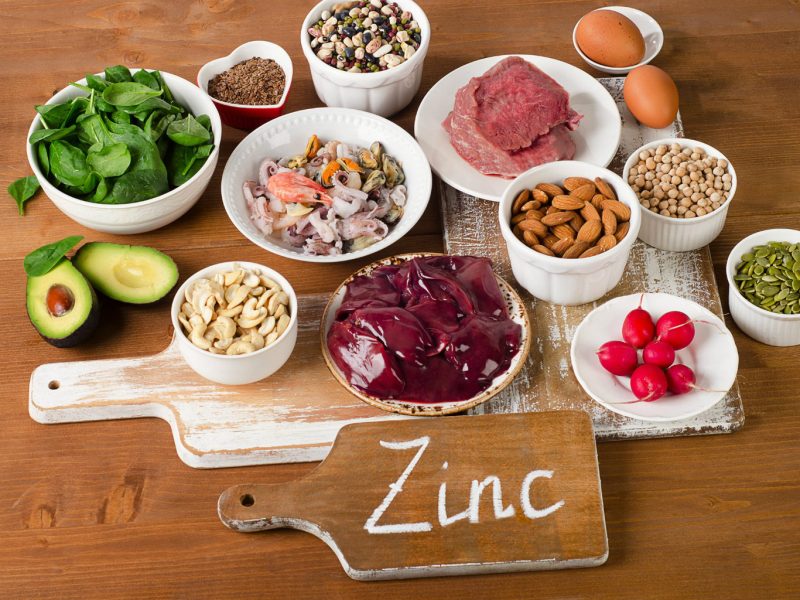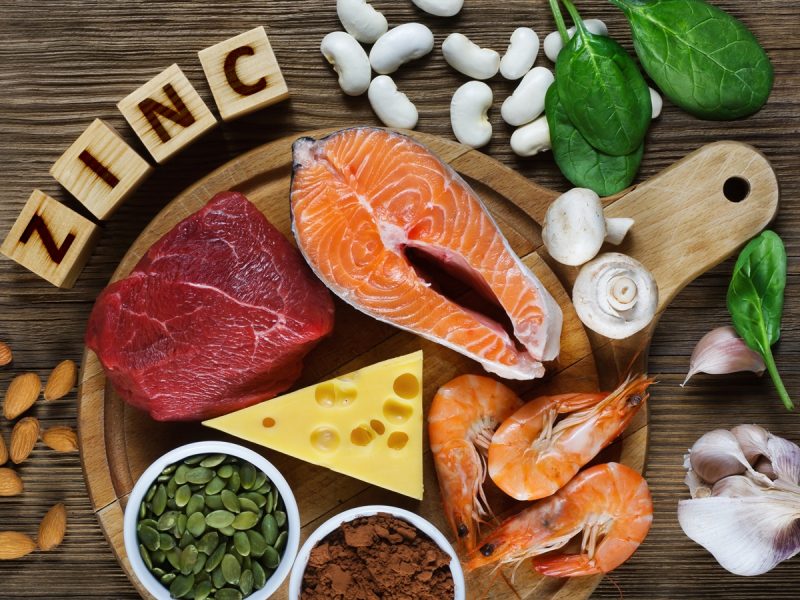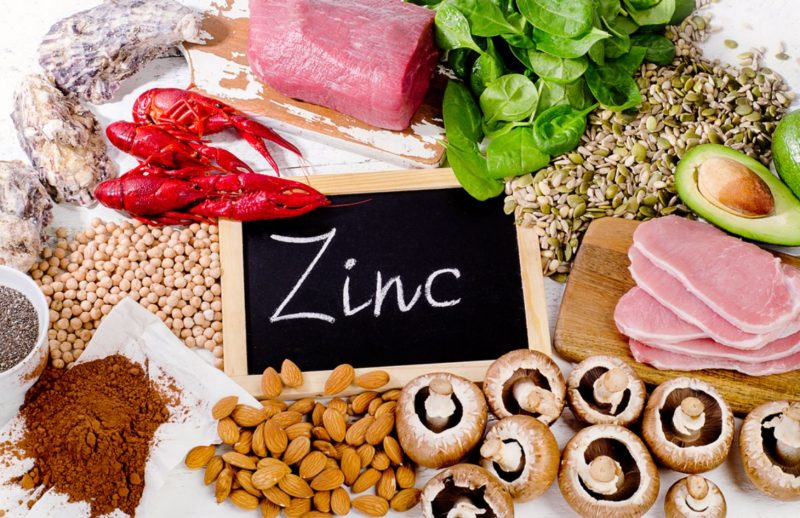Zinc in the body is present in the form of ions that come from food and water. This is a mineral component that is not similar in properties to a simple substance. Contains the trace element zinc in food. Most of it is in whole grains and bran, legumes, oysters, calf liver.
Material Content:
Benefits and harm to human health
Zinc refers to trace elements, the total mass of which is only 10 g, less than 0.01% of body weight. Tissues do not need metal, but its biologically assimilable form - bound ions in the composition of organic substances. Lack of zinc in the body leads to a change in metabolism, weakening of general and local immunity, and a violation of the antioxidant defense of cells.

The trace element Zn is part of the hormone insulin, regulates the activity of more than 200 enzymes, and is involved in the work of neurotransmitters. It is also known about the influence of the mineral component on the processes of blood formation, respiration, the oxidation of fatty acids, and the regeneration of skin lesions.
Zinc belongs to 17 irreplaceable “elements of life”, without which it is impossible to build all parts of cells and the most important compounds for the functioning of organs.
However, the ingestion of an "excess" amount of a trace element with food or tablets threatens with serious metabolic disorders. When the body contains 150-600 mg of Zn, symptoms of intoxication are observed: weakness, abdominal pain, vomiting. The harm can be associated with the penetration of zinc dust into the lungs, ingestion of water or food contaminated with metal production wastes in the digestive tract.
The main symptoms of zinc deficiency
Trace deficiency is due to various factors. Often the cause is starvation. It also happens that the zinc content in food is high, but the body lacks a trace element. The absorption of Zn is impaired in liver diseases, decay and deterioration of nutrient absorption in the intestine, and malignant tumors. Other causes may include medications, parasitic diseases, and the consequences of surgery.

A lack of zinc in combination with a deficiency of magnesium, phosphorus and iron leads to blocking the formation of nucleic acids, proteins, hemoglobin and other vital compounds in the body. The characteristic symptoms of Zn deficiency are stratification of nails, deterioration of hair growth, hair loss, graying, skin diseases, slow healing of skin lesions.
Inadequate micronutrient content affects overall health, even behavior and learning. Immunity decreases, the tendency to allergic reactions, infectious diseases increases. Long-term lack of Zn leads to a change in carbohydrate metabolism, impaired endocrine gland function. Hand tremor appears, hyperactivity develops, attention decreases, and other neurological disorders occur.
Clinical signs of zinc deficiency in children are dryness and roughness of the skin, susceptibility to pathogens, growth retardation and late puberty. A simultaneous deficiency of zinc and retinol activates the sebaceous glands of the skin. Greasy secretion is produced more; exfoliation of dead epidermal cells is disrupted. As a result, favorable conditions for the formation of acne are created.
Daily intake of zinc
The content of trace elements in tissues varies depending on age, body weight and human health. The state of the wall of the small intestine affects the entry of any components from food into the bloodstream.
Malabsorption causes huge damage to metabolism and health. A person eats healthy food, but the necessary substances do not enter the cells.

Nutritionists and doctors in the West recommend that patients in case of malabsorption in the intestine take high doses of vitamins with trace elements.
Breasts require 1 to 2 mg of zinc per day. The physiological need for a trace element increases during periods of rapid growth. Young children need 3-4 mg of trace elements. The need for preschoolers is 5 mg, primary school children increases to 7 mg.
Adolescents need 8–9.5 mg, girls and boys - 7–9 and 10–11 mg, respectively. Women under the age of 50 years - 7-12 mg. The upper numbers correspond to the needs of pregnant women and during breastfeeding. Men need 10–15 mg of Zn daily.

The upper acceptable level for an adult is 25 mg of elemental zinc per day. With physical exertion, during the treatment of a number of diseases, the daily intake rate can be increased to 30 mg. This is what happens with protein starvation, excessive sweating, physical exertion, and treatment with diuretics.
Table: Which foods contain the most zinc?

With a deficiency of any element in the body, it is necessary to eat food rich in this component. Valuable sources are meat, fish and seafood, bread products. From the proposed table, you can understand which products contain zinc in the greatest quantities. Heat treatment leads to the loss of trace elements.
Zinc-rich foods
| Food | Zinc content, mg per 100 g of product |
|---|---|
| Oysters | 7–22 |
| Cereals, bread products | 9–0,7 |
| Brewer's yeast | 8,0 |
| Meat (pork, beef) | from 1 to 8.0 |
| Cheeses | from 3.5 to 4.63 |
| Fish and seafood | from 0.5 to 7 |
| Flax-seed | 5,5 |
| Legumes | from 0.4 to 4.9 |
| Brazil nuts | 4,0 |
| Black tea | 3,2 |
| Walnuts | 2,7 |
| Peanut | 2,8 |
| Cashew | 2,1 |
| Chocolate | 2,0 |
| Eggs | (yolk –3.8; protein –0.02) |
| Condensed milk | 0,78–1,0 |
Zinc-rich foods like wheat bran are valued. When grinding grains, up to 80% Zn is lost, so wheat bread is much poorer in trace elements.
Zinc-rich plant foods
The largest amount of the mineral component is found in cereals and legumes, some seeds and nuts. However, plant foods, as a source of zinc, are inferior to animal products. It must be remembered that heat treatment can be accompanied by a decrease in the number of macro- and microelements.

Relatively High Zn Plant Products
| Food | Zinc content, mg per 100 g of product |
|---|---|
| Wheat bran | 9,2 |
| Pumpkin seeds | 7,0 |
| Soya flour | 4,9 |
| Lentils | 3,4 |
| Peas | 3,3 |
| Cereals | 3,2 |
| Crispbread | 3,1 |
| Refined buckwheat | 2,7 |
| Rye flour | 2,5 |
| White beans | 2,5 |
| Chickpeas | 2,4 |
| Corn Grains | 1,7 |
| Brown rice | 1,6 |
| Whole grain wheat bread | 1,5 |
| Whole grain rye bread | 1,3 |
| Horseradish | 1,24 |
| Broccoli | 0,61 |
| Spinach | 0,6 |
| Brussels sprouts | 0,6 |
| Raspberry | 0,36 |
| Potatoes | 0,35 |
| Leek | 0,31 |
| Zucchini | 0,26 |
| Cucumbers | 0,21 |
| Peaches | 0,15 |
| Apricots | Fresh fruits - 0.14; dried apricots - 0.4 |
| Oranges | 0,11 |
| The apples | 0,1 |
The Zn content in vegetables and fruits is lower compared to cereals and legumes. By drying it is possible to achieve an increase in the concentration of macro- and microelements, for example, in dried apricots and prunes. However, consuming fresh vegetables and fruits remains one of the least costly ways to replenish vitamins and minerals.
High Zn Animal Products
Moderate heat treatment leads to an increase in the zinc content in meat and fish. Products of animal origin are recommended to boil, bake and stew. During cooking, 35–55% of trace elements pass into the broth. When quenching, this figure drops to 7%.

High Zn Animal Products
| Food | Zinc content, mg per 100 g of product |
|---|---|
| Oysters | 22–7,0 |
| Calf liver | 8,4 |
| Pork liver | 6,5 |
| Emmental Cheese | 4,63 |
| Beef | 4,41 |
| Gouda Cheese | 3,9 |
| Tilsit cheese | 3,5 |
| Chicken liver | 3,2 |
| Venison | 3,2 |
| Shrimp | 2,2 |
| Pork sausage | 2,1 |
| Duck | 1,84 |
| Rabbit | 1,7 |
| Lobster | 1,6 |
| Sprat | 1,28 |
| Fried chicken | 1,0 |
| Caviar | 0,95 |
| Carp | 0,9 |
Meat, fish, cheeses are rich in trace elements, in addition, zinc is better absorbed from animal food. Such products are ideal “suppliers” of the mineral component of Zn to the body.
Features of the absorption of zinc
Carotene increases the bioavailability of Zn, and the latter is important for the metabolism of vitamins A, E and C. Lack of zinc exacerbates hypovitaminosis A and E. There may be competition with other ions for the “sequence” of absorption by intestinal epithelium. Such "rivals" are copper, calcium, iron. Zinc deficiency is observed with aspirin.

A variety of food is the key to a sufficient supply of trace elements. Zinc is important for healthy skin and hair, the reproductive, nervous, endocrine systems. Deficiency negatively affects metabolic processes. Replenishment is possible by enriching the menu with products containing zinc in large quantities.
A lot of Zn in oysters, nuts, lentils, seeds, dried apricots. Some of the minerals supply the body with fresh fruits. The diet should be selected so that there are all the necessary nutrients, taking into account possible losses due to malabsorption. In the presence of intestinal diseases, a significant amount of beneficial substances does not enter the body, does not participate in metabolism.

If a micronutrient deficiency causes severe disorders, then natural sources are not enough. It is necessary to take vitamin-mineral complexes, dietary supplements. Unfortunately, the manufacturers of tablets include substances with low bioavailability, for example, zinc sulfate (Zincite, Zincteral). The same problem arises with calcium, the “neighbor” of Zn in the second group of chemical elements. Absorption can be increased by taking organic salts - acetate, gluconate, citrate, zinc picolinate.












